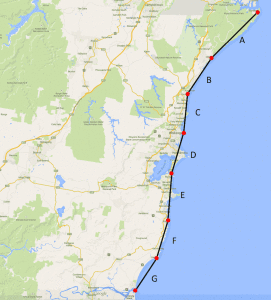
WOTI ran a walk for participants in the EcoArts Australis 2nd National Conference (14-16 February, 2016). A group of about twelve of us started at the Lagoon restaurant and wandered up Fairy Creek, discovering thriving weeds, multiple creek branches and miraculous drainway passages between railway lines and roads. One of our guest walkers, Eva Hampel, wrote the following:
A small coastal creek: degraded, weed-banked, a little creepy, in places almost impenetrable. Thickets of lantana, littered with flood-deposited plastic refuse, time and again bringing us to a halt. But still in some places almost intact casuarina swamp forest with native grasses, beautiful soft couch as an understorey, and the sound of the breeze soughing in the needles overhead. Makes you think: how beautiful must this place have been in pre-European times? What a luxurious, well-supplied living room it must have been when only Aboriginal people lived here – rich with fish, shellfish, tubers, native spinach and other native plants, with fresh water plentiful nearby, and soft grass on which to sit and feast.
For how long did this idyllic environment survive European settlement and the disturbance of agriculture? For quite a while it must have remained beautiful: a place of refuge for wildlife, for Aboriginal owners a setting for continued occupation (where allowed – that history is not pretty), for European settlers a place for picnics and swimming; shaded, wind-protected, and with deep still pools, waterbirds, and quiet reflections. But gradually the weeds would have moved in – and with industrialisation of the area, the neglect of peripheral spaces: behind the factory, beside the road/rail/driveway, bordering the parking area; weeds have been allowed to grow unchecked, and the degradation is almost complete.
And yet what a treasure these passages could be! These are ribbons of largely public space, reaching from deep in the coastal suburbs to the surf beaches: see them as ribbon parklands, perhaps a cycleway, at least a creekside track. Large-scale weed clearance would be needed, but once the worst was cleared out, local groups would likely be roused to their defence, once they became a public asset, a path to the ocean. Even now hardy dog-owners manage to navigate them in parts, graffiti artists use drainage tunnels as canvases, and hideaways have been built here and there, despite a vague sense of threat and possible sinister things. These are spaces that people value – if some are brave enough to inhabit them now, how many more would use them once the sense of potential threat had been removed?
Should this be a call to arms? Could the local Council, perhaps cash-strapped, certainly with priorities firmly set on ‘front-of-house’ spaces – like roadways, established parks, formal sports playing grounds – be encouraged to view these spaces as assets, local spaces for local people, along with the beaches and escarpment which are iconic local attractions? Is it just the idealist in me, blended with the compulsive planner and landscape architect, that cries at the lack of vision and waste of this approach to such spaces?
Can art change the world? Well, certainly it can build a groundswell for action. I think this is a call to arms….
Eva Hampel

